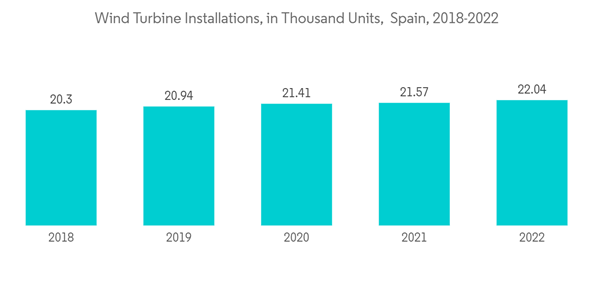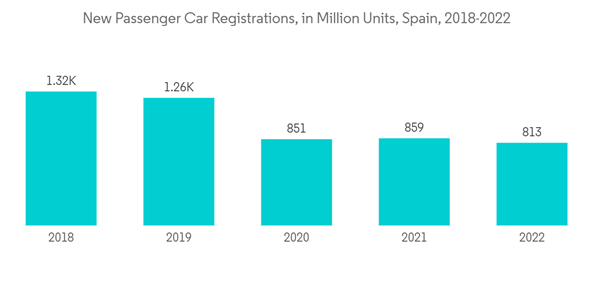The Spain Lubricants Market is estimated to reach 378.21 million l by the end of this year and is projected to reach 382.54 l in the next five years, registering a CAGR of less than 1% during the forecast period.
The impact of COVID-19 on the lubricants market was adverse in Spain. Demand from the major automotive segment witnessed a steep fall owing to the decline in sales units of vehicles. However, the demand substantially recovered with the reopening of 2021 but remained way below the pre-pandemic levels.
This product will be delivered within 2 business days.
The impact of COVID-19 on the lubricants market was adverse in Spain. Demand from the major automotive segment witnessed a steep fall owing to the decline in sales units of vehicles. However, the demand substantially recovered with the reopening of 2021 but remained way below the pre-pandemic levels.
Key Highlights
- One of the major drivers for lubricant demand in Spain is the consistent increase in investments in the power generation industry.
- However, the growing production of electric vehicles will likely restrain the growth of the lubricants market in Spain.
- Growing research and developments in synthetic and bio-based lubricants will likely create opportunities for the market studied in the coming years.
Spain Lubricants Market Trends
Growing Investments in the Power Generation Industry
- The power generation industry uses a variety of high-performance lubricants to improve the reliability and maximize the uptime of critical equipment like turbines, generators, pumps, gearboxes, and others.
- Different power generation segments use lubricants with different properties. For instance, the wind energy segment requires gear oils, greases, and hydraulic oils with weather-resistance properties. In contrast, hydropower plants require turbine oil, gear oil, lubricants, and hydraulic fluids with excellent water separability and corrosion resistance.
- Spain's demand for electricity is increasing across all sectors. In the last decade, electricity generation in Spain profoundly decarbonized since the production of electricity from fossil fuels decreased.
- Renewable energy is the primary electricity provider in Spain, followed by natural gas, nuclear, coal, and oil. Spain embarked on achieving 74% renewable electricity generation by 2030, in line with National Energy and Climate Plans.
- In 2022, wind was Spain's main renewable energy source, representing roughly half of the electricity from renewable resources. The wind power capacity installed in the country was the highest of all the renewable and non-renewable generation technologies.
- In 2022, as per the Asociación Empresarial Eólica (AEE), which is the Spanish Wind Energy Association, the country had 22.04 thousand wind turbines installed. It showcases an increase of nearly 2.17% compared to the previous year.
- The Spanish government is actively investing in increasing the number of wind energy farms to reach 50 GW of installed capacity by 2030. Several private companies are also investing in the segment, anticipating a further increase in demand in the coming years.
- In June 2022, Iberdrola, an electrical utility company in Spain, signed a loan agreement with the European Investment Bank for EUR 550 million (~ USD 601 million). It is for constructing new wind farms and solar photovoltaic power plants with a total installed capacity of 1.8 GW.
- All the factors mentioned above positively impact the demand for lubricants from the power generation industry in Spain.
Engine Oil Segment to Dominate the Market
- Engine oil is a key lubricant in the combustion cycle and comprises base stock and additives. Engine oils are primarily used to lubricate engine parts constantly in friction. Engine oils are applied in various end-user industries, including automotive, power generation, heavy-duty equipment, etc.
- Engine oils reduce the tension between the contact of parts and enhance heat transfer by forming a thin layer between the moving components. The automotive industry is a substantial consumer of engine oils as these are essential for the smooth running of engines, reducing fuel emissions, and improving the overall performance of engines.
- Spain is the second largest automotive manufacturer after Germany in the European Union. However, the automotive industry in Spain witnessed a decline in 2022 in terms of production and sales.
- As per the Association des Constructeurs Européens d'Automobiles (ACEA) statistics, new passenger car registrations in 2022 stood at 813 million units, showcasing a decline of nearly 5.4% from 859 million units in 2021. Even though overall passenger car registrations declined, an increase in the registration of electric and hybrid vehicles was witnessed in 2022. Since lubricants are not viably utilized in these vehicles, the shift in trend is expected to negatively impact the market in the coming years as well.
- Since engine oils are utilized in various heavy-duty equipment in the construction industry, the performance and investments in the construction industry in Spain also influence the demand for engine oils.
- Several investments in large-scale housing projects were witnessed by private companies in 2022 that require heavy machinery for construction activities. For instance, Las Lomas del Higueron Residential Complex Project, worth ~USD 696 million, was onset in Q1 2022. The project aims to meet the increasing demand for luxurious apartments. The project will be completed at the end of 2025.
- All the abovementioned factors will likely influence the demand for engine oils in Spain's lubricants market.
Spain Lubricants Industry Overview
The Spain lubricants market is consolidated in nature. Some of the market's major players (in no particular order) include BP p.l.c., Cepsa, Repsol, Shell Plc, and TotalEnergies SE.Additional Benefits:
- The market estimate (ME) sheet in Excel format
- 3 months of analyst support
This product will be delivered within 2 business days.
Table of Contents
1 INTRODUCTION
4 MARKET DYNAMICS
5 MARKET SEGMENTATION (Market Size in Volume)
6 COMPETITIVE LANDSCAPE
7 MARKET OPPORTUNITIES AND FUTURE TRENDS
Methodology

LOADING...










